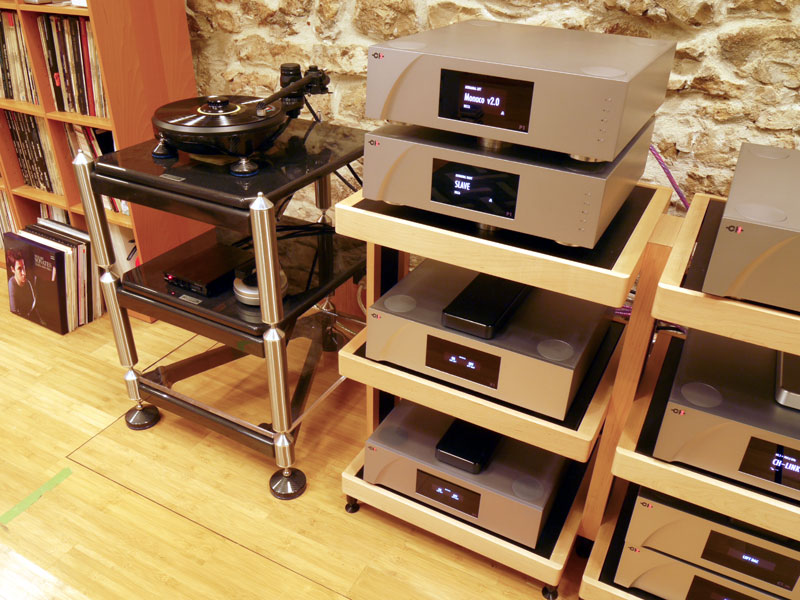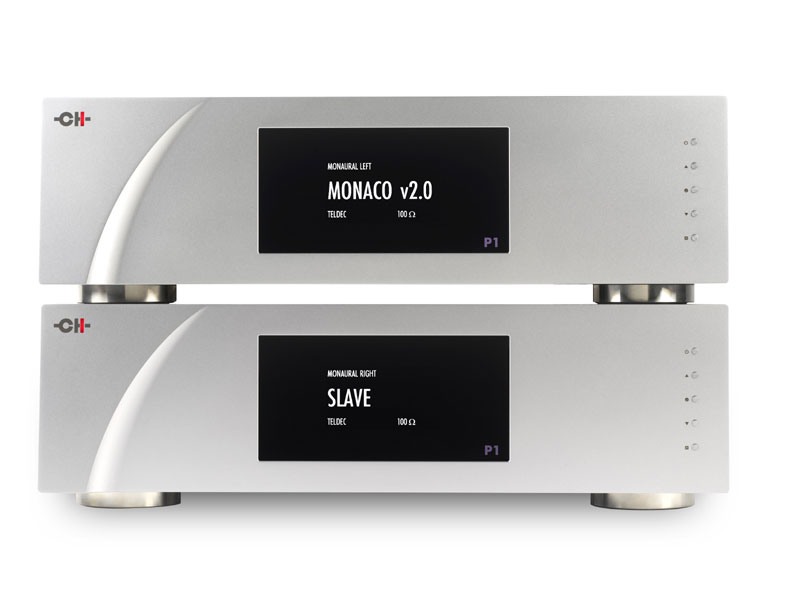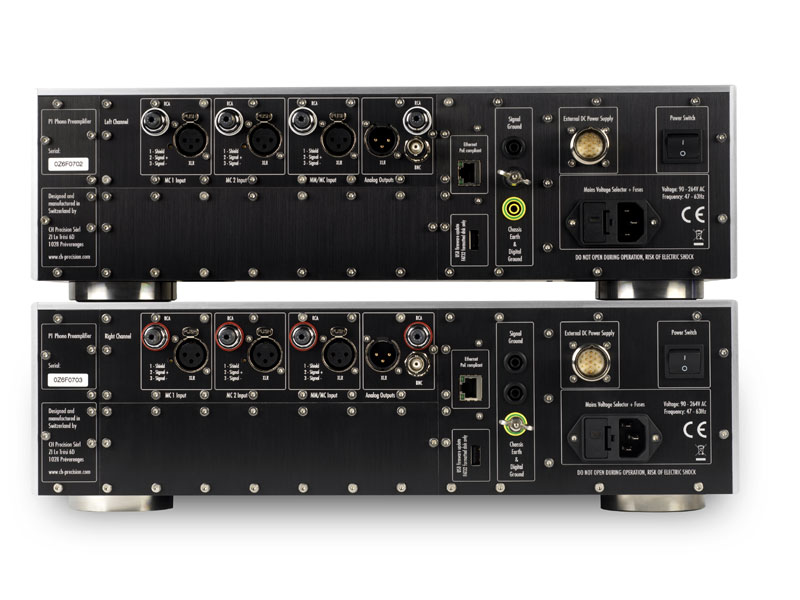Natural Expansion: Going True Monaural with the CH Precision P1 Phono
Stage
ack in May 2018, I concluded my review of the CH Precision P1 phono stage, L1 line stage and M1 power amp with an observation: not only did the performance of this set of electronics justify the ruinous cost of ownership, the existence and significant musical impact of the X1 external power supply made it an essential part of that equation. But it also stretched the purse strings further still, by adding one extra box and allowing the inclusion of as many as six additional units to the system. Six? CH Precision really does take the modular and dual-mono ethos to its logical extreme, so while the X1 can carry output cards for two individually regulated DC supplies (allowing a single X1 chassis to power both a P1 and an L1), the option also exists to use dedicated, single-output X1s for both the P1 and L1, or even for each channel of the low-level electronics -- in which case the left- and right-channel circuits of the L1 or P1 are split, each housed in its own individual chassis. Follow that through with the P1, as an example, and your upgrade path runs: standalone P1, P1 with X1, twin-chassis P1 Mono with X1 (dual output), P1 Mono with two X1 power supplies -- voilà, a four-box phono stage, with the same logic applied to the line stage. If you thought that the single-box P1, L1, X1, and M1 setup was beyond mortal means -- and it is certainly beyond mine -- the realization that it’s merely the first rung on a very tall ladder could be considered as shocking as it is obscenely extravagant. Dissing and dismissing this sort of ultra-high-end product has become increasingly fashionable, as such products have become increasingly common. However, the fact that you or I cannot afford something makes it neither unjustifiable nor irrelevant. In fact, there are plenty of people who can (and do) buy such products, and the same values and questions apply to them as apply to more affordable alternatives. Value might lie in the eye and ear of the beholder, but performance is relative and measured on the same scale as every other audio component. On paper, the progression to a four-box phono and/or line stage looks almost ostentatiously ludicrous -- living proof of the law of diminishing returns. Except, not only does the addition of the X1 to the P1/L1 pairing transform its performance, raising the question of just what does happen when we start adding more (and more) power supply, but we don’t need to speculate. The uniquely modular nature of the CH Precision line means that we can find out just who is kidding who. I might not be able to afford the full P1, L1, X1 , M1 rig, but as the owner of a P1/X1 combination (yep -- the performance was convincing enough to separate me from my own hard-earned cash) I for one would sure like to know.
But, first things first; just how much coin are we talking here and how does the upgrade path work? A stock P1 weighs in at $31,000 USD (plus $1850 if you add adjustable replay EQ), with the X1 adding a further $17,000. A second output card for the X1 adds a further $3500 while the twin-chassis P1 Mono will set you back $55,000. I guess the good news is that CH Precision operates a trade-in scheme, where you can take the intervening steps without cost penalty, meaning that a full, four-box setup will cost you exactly the same whether you get there by stages or simply jump in right at the top. Either way, that means the grand total is a slightly eye-watering $89,000 -- with the same range of options available for your L1 too. Someone, somewhere definitely said, “The three most important things in audio electronics are power supply, power supply and power supply.” In fact, the statement is so demonstrably obvious that it has probably been said by many people, in many places, at many times. Look no further than the success of companies like Naim and DNM, which built entire product lines on the notion of upgrading performance by simply adding more and more external power supplies for the proof of this particular pudding, while the benefits of the P1/X1 pairing over the standalone unit are so smack-you-in-the-face obvious that using either a P1 or L1 in isolation simply makes no sense. While putting numbers on such things is almost impossible, my gut (and my wallet) says that in both cases, the addition of the power supply more than doubles the available performance -- while adding around 50% to the overall price. If this is an example of the much-quoted law of diminishing returns, I’ll happily accept the musical and financial consequences. The question is, do those impressive gains in performance hold good across the whole upgrade path? Having wheedled and cajoled the necessary boxes out of CH Precision, I think it’s time to find out.
But before we do that, one final note: I’m not going to wade through the P1’s comprehensive range of options and facilities. I did that in the original review, so if you are not familiar with just what makes this phono stage both so versatile and increasingly, the go-to choice for vinyl-committed reviewers and end-users alike, you should start by reading that original piece. Having already established the near necessity of using the X1 to feed the P1, we don’t need to dwell on the nature of the improvements so much as their scale. As exhaustively detailed in the original review, the external power supply adds a sense of rooted substance, presence and authority to the music, with increased bass weight and definition, a lower noise-floor and wider dynamic range. Of course, that was with the P1 sharing the X1 with the L1. Giving the P1 its own, dedicated power supply simply adds to the sense of purpose and power behind the playing, an even more emphatic result, whether you want to measure it in terms of musical intimacy and delicacy or sheer brute power and impact. Either way, once heard, the X1 becomes indispensable. Does taking the next step along the path deliver just as big a musical dividend?
Interestingly, in this case, we’re not increasing power-supply size so much as increasing channel separation, with the P1 Mono chassis literally splitting the already separate left and right audio circuits between discrete boxes. On a standard P1, the left- and right-channel connections are arrayed in a pair of parallel rows, one above the other. Step up to the P1 Mono and you get two boxes, each with a single row of socketry -- it really is as simple as that. Of course, each chassis retains its multi-pin connector for use with the X1 external supply -- although, in theory at least, you can use the P1 Mono as a standalone, two-box solution. Trust me -- the P1/X1 combination makes a whole lot more sense, both musically and financially. The three-box option pairs the twin audio chassis with a single X1 fitted with two output cards, one for each channel. How does P1 Mono sound? Obviously and demonstrably different is the quick response, but as I’ve already pointed out, it’s the scale and nature of those differences that are crucial to establishing their value. First up -- and not really surprising given the nature of the physical changes to the units -- is an increase in transparency and separation. On the opening of the Decca recording of Britten conducting his Young Person’s Guide . . . [Decca SXL 6110], the densely orchestrated bass strings, brass, winds and rolling percussion have greater separation and more obvious locational and textural distinction than they do on the P1/X1. The stage is wider and with greater height to go with the expected depth that so often characterizes Decca recordings, while the space within the stage is blacker and the dynamic range and impact have improved. So all good then? Well, yes and no. Look again and you might notice that the differences I’ve outlined are largely cosmetic or presentational in nature. Yes, the P1 Mono does an awful lot of hi-fi things better than its standard stereo sibling, but when you start to ask whether it is better in musical terms, things become rather more ambiguous. All that separation and resolution make it easier to hear what’s there, but they don’t necessarily help you understand what the players and instruments are doing. Along with that extra transparency comes a loss of substance and presence, a slightly restrained, almost considered quality taking over from and diminishing the sense of musical power, drive and purpose that makes the P1/X1 so engaging and musically enjoyable. It’s a tendency that’s counteracted at least in part by the increase in dynamic range and jump, but there’s no escaping the loss of flow and the easy, communicative coherence of the stereo rig, the sense of shape and substance it brings to the performance. In other words, although the P1 Mono allows you to hear more, you don’t necessarily learn more -- at least as regards the motivation or message behind the playing. All of which makes what happens when you add an extra X1 to the mix all the more intriguing and impressive. Stepping up from one external supply with two output cards to a pair of supplies so that not just the regulation but the power transformer and reservoir are dedicated to a single channel absolutely transforms the results. Not only does it extend the sonic benefits heard with the introduction of the P1 Mono, it grafts them seamlessly onto a turbo-charged version of the P1/X1’s sense of musical substance and flow, increasing its expressive range and the directness of its communication. The result is a presentation that steps away from the speakers entirely, setting the musicians in a clearly defined acoustic space (one with walls, a floor and a ceiling) that reaches forward to embrace the listener. The opening bars of the Britten have power, purpose and impact, the instruments gaining substance and a sense of place (in space), the musicians gaining poise and a sense of place (in time). Suddenly, the orchestra isn’t just present; it’s playing together and it’s playing for you. The instruments are effortlessly identifiable (rather the point of the piece after all), the contrasts in drama and scale between the heavily orchestrated majesty of the main theme and the individual, almost teasingly sporadic solo interjections in the intervening passages beautifully illustrative, paced and structured. In material terms I can point to increased dynamic range and bandwidth, but those increases are ultimately minimal and in no way reflect the huge increase in musical engagement, connection and enjoyment that results. In terms of quantity, I might possibly invoke the law of diminishing returns, but the quality that results from the addition of the extra X1 makes a nonsense of that. This has nothing to do with delivering more signal; it’s all about how easy it is to understand the signal that’s already there. Perhaps it’s time for a different example -- the Rostropovich/Karajan/BPO recording of the Dvorak Cello Concerto [Deutsche Grammophon Gesellschaft SLPM 139044]. This 1969 issue might seem like an unlikely choice, given its less than stellar reputation and the fact that it hails not just from DGG but Karajan too -- two potentially turgid influences that even the great Rostropovich might struggle to overcome. Except that it serves perfectly to demonstrate the real benefits of the CH Precision P1 in general and the four-box P1 in particular. I’m referring in part to the phono stage’s option to include switchable replay EQ, pretty much essential to anybody listening to pre-CD pressings of classical or jazz records -- and not just those dating from before 1956. Once you realize that DGG used the Teldec curve (rather than RIAA) right up to the point where they stopped issuing vinyl in favor of CD, it’s easier to understand why their records have such an appalling reputation amongst collectors, despite the stellar roster of artists featured. Even a cursory comparison between the Dvorak disc replayed with the RIAA and Teldec curves reveals just how musically destructive the wrong EQ can be -- and just how dramatic the transformation with the correct EQ applied. Not for nothing was Rostropovich recognized as the preeminent cellist of his day -- an era that featured several astonishing performers in their own right (Fournier, Tortelier, Du Pré and Starker, to name a few). Hearing his performance on this DGG recording, properly replayed, is a revelation -- not just in terms of the solo playing but also the sensitivity, drama, control and purposeful coherence of the Berliner Philharmoniker under Karajan’s baton. “Karajan” and “sensitivity” used in the same sentence -- who’d have thunk? But that’s exactly the point. As impressive as the Dvorak disc sounds with the P1/X1 doing the equalization and amplification, moving up to the four-box setup releases whole layers of musical and emotional sense and sensibility, from the measured intensity and power of that famous opening passage to the anticipation it creates for the solo entrance, from the sheer dynamism of Rostropovich’s playing to the almost physical sense of his presence, the action of his bowing generating the energy that makes the air quiver. Just as with the Britten, the four-box phono stage brings the performance vividly and dramatically to life, instilling it with a vigor and presence, power and sensitivity that reach out directly to the listener. The separation and instrumental identity, space, air and tangible acoustic bring impressive and unequivocal clarity to the recording and performance. But it is the sense of musical authority and the way it banishes ambiguity that makes the four-box P1 so incredibly satisfying. If the cleverest part of any audio system is the bit that’s between your ears, then the better the system, the easier it makes the job of decoding the performance. By the same token, if vinyl replay starts with an advantage in this regard, then the flagship CH Precision phono stage takes that advantage and rams it home -- all the way home. The real difference between the already superb P1/X1 combination and its four-box big brother is just how effortlessly communicative and engaging your records become once you reach the top of this particular ladder. There is no question or confusion over what is being played or by whom. The P1 Mono with a pair of X1 supplies simply lifts that performance captured in the vinyl’s groove, away from the system, away from your speakers, and re-creates it in front of you, bringing the frisson of the original event to your room and transporting you to the original event. That’s what makes the four-box P1 way, way better than the two-box P1/X1 option. Twice as good? No, much, much more than that. Of course, opening the window between your record player and your system this wide will only reap the maximum musical dividend if each stage of your system and setup allows it to -- and it’s surprising how often that isn’t the case, even where customers are spending this kind of money. But you have to start somewhere, and there’s nowhere better than right at the front of the chain. Installing the four-box P1 is the audio equivalent of taking your system’s foot off the throat of the fragile phono signal. Doing so gives the rest of your system an awful lot more to work with -- and deliver -- if you let it. If it doesn’t deliver, don’t blame the phono stage. Instead, go to work on your infrastructure, setup and speaker positioning -- and just listen to your system bloom. Where does all this leave P1 owners? With one foot firmly on the audiophile Yellow Brick Road -- a clearly defined and cost-effective upgrade path. Adding the X1 is, as I’ve hopefully made clear, a complete no-brainer. Astonishingly, the four-box option is even more compelling, assuming you’ve the coin to afford it. Sadly, at least from a personal point of view, the only short step on the ladder is the one from two boxes to three, a move that improves the sonic aspects of performance at the cost of undermining the musical integrity of the whole -- a shift sideways at best and arguably backwards, at least in terms of musical pleasure. Which rather underlines just how apposite that old adage concerning power supplies really is. CH Precision has crafted one of the most impressive,
versatile and upgradeable phono stages ever offered to the listening public. Its value
confounds its price just as surely as its performance exceeds expectations. Keeping the
rungs on the upgrade ladder perfectly even as well might have been a step (or a fond hope)
too far, but that does nothing to undermine the P1, a product that provides not one but
three benchmarks when it comes to the best available performance from vinyl records: one
box, two boxes or four, the CH Precision P1 really does set the price/performance standard
against which all others should be measured. |



